FAQ and How-To Series articles. The EasyPro Pro Staff answers water garden, pond and lake questions. Includes easy-to-follow, printable guides.
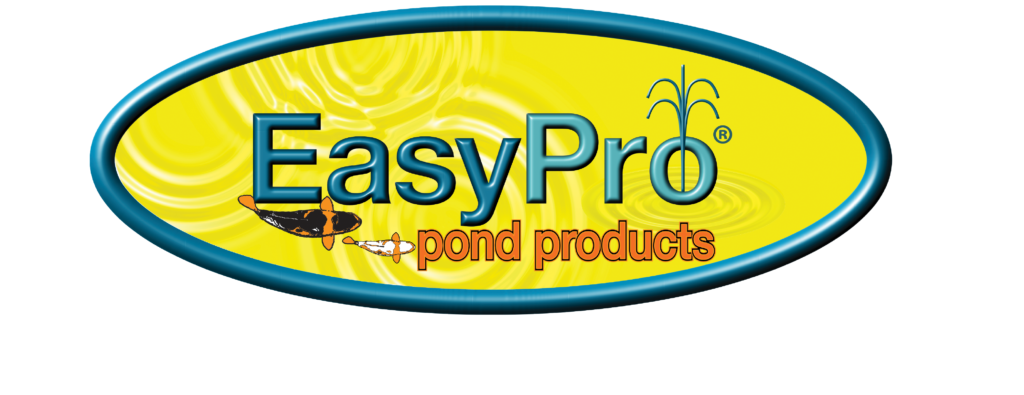
Ornamental ponds and waterfalls are becoming an everyday part of our landscape: homes, businesses, parks, zoos, apartment complexes, and office buildings. Everywhere we look, people are wanting to add water to their landscape – and for good reason! Only a few other things are as relaxing as the sound of splashing or running water. For centuries, other parts of the world have used water as the focal point of their landscaping. This trend is now catching on in the U.S. as well.

EasyPro is one of the country’s largest manufacturers and suppliers of pond and waterfall products to the landscape contractor/garden center market. We have seen an explosion of interest and demand for pond products over the last few years. Because this industry is young, there is still a lot of confusion and misinformation about the proper way to construct a pond. Your pond is an investment that, if properly done, will provide years of enjoyment, or if improperly done, will provide years of turmoil. EasyPro has been in the fish and pond business for over four decades. Combined, our staff has over 100 years of combined experience that you are welcome to draw from when designing your “dream pond.” Whether building a new pond or maintaining an existing one, you can rely on us for all your aquatic needs.
Your pond should be located in a spot where it can be enjoyed the most. Locating the pond near a window or alongside a deck will allow you to enjoy the pond more than if the pond was located out in the middle of the yard. Ponds should not be located in the low spots of your yard. These low spots gather rainwater runoff, something you do not want in your pond.
Most books will tell you ponds need at least four to six hours of sunlight per day for proper plant growth. While aquatic plants (lilies, cattails, etc.) prefer sunlight, they will do just fine in shady areas as long as slow release aquatic fertilizer tablets are added a couple of times per year. Shady ponds tend to have less algae problems.
Do not build a pond too close to a tree. Building a pond inside a tree’s “drip zone” can damage tree roots. Tree roots will not grow through or puncture a pond liner.
A pond is not complete without landscaping. Locate your pond so there is ample room to landscape around it. It will take some time after your pond is installed for the plants to fill in and complete the setting.
A waterfall and/or stream should be located at the back of the pond. This will allow you to see the water feature as you approach the pond, as well as increase the sound of the splashing water.

Ornamental ponds often need supplemental filtration to maintain proper water quality. Filtration involves two parts: the first step is mechanical. This step removes particles from the water like leaves, grass clippings, dead plant foliage, etc. Pond skimmers are by far the best mechanical pond filter we have seen yet. Biological filtration is the second stage and is especially important for ponds with fish. Biological filtration keeps the water healthy and clear. The filter media inside a bio-filter collects beneficial bacteria that cleans the water as it passes through the filter.
All pond filters are rated for maximum pond size or maximum GPM flow. To properly filter the pond, your filter needs to be able to filter half the pond volume per hour.
Example: A 1,000 gal. pond would need a 500 gal. per hour filter.
We recommend using an external biological filter. This filter can be located directly next to the pond or concealed by plants, rocks, or bushes away from the pond. Water is pumped from the pond through piping to the filter and then back to the pond. Our AquaFalls filters are ideal since they bury in the ground for easy concealment, require minimal cleaning, and provide an ideal base for your waterfall/stream.
Aquatic plants are an important part of the filter system. Plants absorb nutrients from the water thereby reducing the nutrient load in the pond, which helps your filters. Oxygenating plants are especially beneficial because they not only filter but also add oxygen to the water.
Ultraviolet clarifiers (UVC) are a popular way to control pea soup-colored water. Pea soup green water is caused by an excess of free floating algae cells. UVCs destroy all living cells in the water as they pass through. If you are adding bacteria to your pond, you will want to shut off the UVC before adding the bacteria, then restart after 24 hours.

Flexible pond liners are by far the material of choice for the do-it-yourselfer. Using a flexible liner does not limit you to a specific size and shape as the preformed ponds do. EPDM Pond Liner is the #1 choice for water gardening because it is very flexible, puncture resistant, and long lasting. For lining large ponds, we recommend the polyethylene material because it is lightweight, easier to handle, and less expensive than rubber. Also, polyethylene liners can be made up to 60,000 sq. ft. in one piece.
For a water garden, add the depth twice to both the length and width. Then add at least 1′ to both numbers for liner overhang. For a large pond, add the depth at the deepest point to the length plus the width. Then add 5′ to each figure to allow for burying around the edges.
Example: Pond size 30’W x 50′ L x 10′ deep
Width = 30′ plus 10′ (depth) plus 5′ (burying) = 45 ‘
Length = 50′ plus 10′ (depth) plus 5′ (burying) = 65’
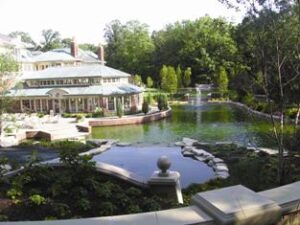
Always try to line your pond with a one-piece liner. There are special tapes available for seaming liners together, but do this as a last resort. Our EPDM liner has a 20 year warranty. Think about it: trying to save a few dollars on a cheap liner may well cost you a lot of time and aggravation in the end. If your liner cracks or punctures easily, you will have to drain the pond, remove all stones and the old liner, and start over. Save yourself the time and money; use quality materials the first time. Our 45 mm. rubber liner, when installed with the protective underlayment beneath it, will provide years of enjoyment for you.
We have found that covering the liner in a water garden with natural fieldstone will help protect the liner from sunlight, animals, etc. Ponds also look better with a natural stone bottom, and if your water level drops a few inches, you won’t see a strip of liner exposed around the top of the pond. The stones also provide a large surface area where beneficial bacteria will grow and help clean the pond’s water. We recommend covering the liner in water gardens with 3″ – 6″ fieldstone then sprinkling 1″ stone over the pond to fill in the cracks between the larger stones. Feel free to mix in some larger stones for a natural-looking water garden.

It’s common knowledge that a reservoir has to be built large enough to hold adequate water for the size feature you are building. On large projects, the reservoir can get pretty big. Making a natural-looking stone bottom can be a challenge. EasyPro designers often have oversized the liner on the reservoir, which allows you to wrap liner over the top of the cubes and greatly reduce the size of visible stone area.
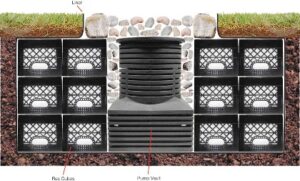
Ponds and lakes are a valuable natural resource. They add beauty to the landscape, provide recreation, and are a habitat for fish and wildlife. A natural body of water is a complex biological, chemical, and physical community. The quality of the water determines the health of the entire ecosystem and the aquatic organisms living within it – from microscopic bacteria to large fish.
The “engine” that drives everything within a body of water is the presence of oxygen in proper levels. A pond’s condition deteriorates when its bottom environment cannot support aquatic life. The bottom is where the most oxygen is consumed and the farthest from the surface where it is replenished. Without adequate oxygen at the bottom, beneficial bacteria do not break down the organic waste. This results in increased layers of sediment (muck) along the pond bottom. Simply put: without oxygen, a pond cannot clean itself. Years of experience has taught us that three main tools are needed to manage ponds and lakes:
Aeration. Bubbling fountains and diffused air systems are commonly used to increase the natural levels of oxygen. The added oxygen and, equally important, the circulation created by these devices help to create a stable and productive ecosystem. Fountains typically float on the surface and spray water up into the air. As the water droplets fall back to the surface, they pick up oxygen. Fountains also create surface ripples and circulation, which help to keep the surface clean. Diffused air systems utilize a shore-mounted air compressor that pumps oxygen through a hose to a special diffuser lying on the pond bottom. Since the bottom of the pond is where the most oxygen is consumed, it is an ideal way to deliver oxygen to where it’s needed most. As the bubbles rise out of the diffusers, they create a “lifting” or boiling action, which creates considerable circulation throughout the pond. This circulation helps to prevent water stratification.
Beneficial Bacteria. For over two decades, we have been using bacteria to help Mother Nature keep waters clean and clear. Back then, very few companies were using this approach, and we got quite a few funny looks when we told people to add “bacteria” to the water. Today, thousands of happy customers later, the use of natural bacteria to help reduce sludge build-up and increase water quality is widely used and embraced. By adding billions of these naturally occurring organisms, you can reverse the aging process of ponds that occurs when fish waste, leaves, dead weeds/algae, runoff, etc. start to build up on the bottom. The results are improved water quality, reduced odors, improved oxygen levels, and a better environment for fish and other aquatic life.
Weed and Algae Controls. There are a wide variety of treatment products available to safely control aquatic weeds and algae in ponds and lakes. These tested and approved products are a safe and quick way to gain control of waters that are infested with aquatic weeds or algae. The use of these products is a good short-term solution to a problem; however, to gain more long-term control, you should look at the overall ecosystem and determine what the real cause of the problem is. Often aeration and/or the use of bacteria will greatly improve the system and the use of these chemicals can be reduced.
Algae grows in various forms. Filamentous algae is most common. It grows in strings or mats – often on the surface. Planktonic algae causes green water. It consists of millions of individual cells that cloud together. Chara is a weed-like form of algae. It grows like a carpet along the bottom of the pond. It has a musky odor and feels gritty. Use Cutrine liquid on filamentous and planktonic and Cutrine granular on chara.

Emergent plants grow around the perimeter of a pond in shallow water with all or most of their foliage above water. Cattails, Bulrush, Reeds, Purple Loose Strife, Pennywart, and Pickeralwood are common emergents. Use Shore Clear for best control.

The pondweed family has over a dozen varieties. Each of these plants can grow in deeper water – up to 10′ deep in clear water. Sonar, Aquathol Super K, and Hydrothol work well to control growth.

This plant grows in thick clumps and is usually not a big problem. The leaves are in whorls of three around the stem. It also grows in deeper water like pondweeds. Komeen or Reward are most commonly used to combat Elodea.

Duckweed is hard to control. It forms a thin layer over the surface in calm, wind-free ponds. Duckweed will not grow well in moving water, so use of a surface aerator will help in controlling growth. For chemical treatment, Clipper or Sonar are good choices. Often, only one Sonar treatment will last for multiple seasons. Reward or Weedtrine mixed with Cutrine and a surfactant can also be used, but regrowth can occur quickly if application is not done properly.

While beautiful to look at, waterlilies can become a problem in many ponds. They grow off of a large central root system. Some growth is great for shade and cover for fish, but when left unchecked, they will over populate. Use Navigate to control unwanted growth. Shore Clear/AquaNeat with surfactant will also work if used after blossoms appear.
A very prolific plant that spreads easily since fragments of plant can re-root and grow. Do not try to remove by raking. Grows very dense, making swimming and boating difficult. Sonar or Navigate are best for treatment options.

Naiad, Coontail, Bladderwort, Hydrilla, Parrot Feather, Water Hyacinth.


EasyPro offers a wide selection of aquatic weed and algae control products, along with nearly five decades of experience. Controlling nuisance aquatic plants and/or algae is a problem nearly every pond owner is forced to deal with sooner or later.
There are several ways to go about treating a pond. Ideally, you will take some time and understand what is causing the problem. Once you understand what is causing the problem, it makes future treatment and control much easier. Following are some ways to improve water quality and control aquatic growth:
Utilizing aeration will do several things. First, it maintains higher oxygen levels in the pond, particularly near the bottom. This allows organic materials to decompose rather than accumulate. Secondly, aeration will allow natural and added bacteria to work faster at digesting the nutrients in the pond. Third, moving water is much healthier than stagnant water. Aeration will prevent stratification of the water, creating more uniform water temperatures from top to bottom.
Adding beneficial bacteria to your pond is extremely helpful in removing excess nutrients. EasyPro Pond-Vive is used by thousands of pond owners to help control muck buildup. This muck, if left in the pond, contributes significantly to future weed and algae growth.
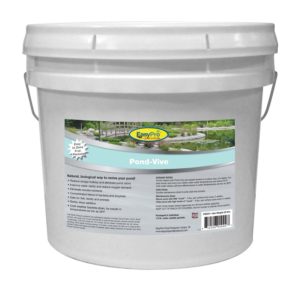
The use of safe aquatic chemicals is the most common form of treatment. Each of the products we offer is safe for humans, fish, and pets when used in accordance with the label. Be sure to read and follow all instructions on the manufacturer label.
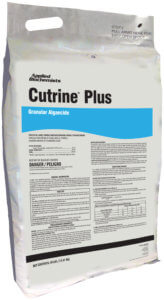
Aeration, bacteria, or chemical use alone will not usually solve the problem. Used in conjunction, however, these products are extremely effective at reducing problems and improving water quality. Please contact us for assistance in determining the best plan of action for your pond.
Proper identification is crucial to the success of any chemical treatment. Many aquatic weeds look very similar but some require totally different products to control them. We have pictures of many popular plants in our Identify Aquatic Weeds & Algae section. If you can safely identify your weed(s) from one of these pictures, then you can select the proper treatment from our Chemical Selection Chart. If you are unsure, please contact us for assistance.

In freezing climates it is recommended to remove pumps from ponds and water features to prevent damage due to ice. Winterizing your pump will vary a bit by type of pump you have. We actually recommend that submersible pumps with mechanical seals (TH, TM, TLS, TB or other direct drive pumps) be stored in water up to just above the seals. The mechanical seal is located where the shaft exits the motor housing and enters the “pump” chamber. By keeping this wet the mechanical seals won’t experience a “drying” out. The outer casing of the pump can be cleaned at this time as well if scale or hard water build up is evident.
A mag drive style pump may benefit from cleaning of the impeller, magnet and chamber. Remove the outer screens if applicable and the impeller cover/volute from the pump. Then carefully remove the impeller assembly from the pump. Inspect the impeller and magnet for debris or build up. Remove any build up with water, vinegar and non-abrasive rag or pad. Then carefully reassemble the impeller assembly and the outer coverings. A video that covers this process can be seen at our YouTube channel. A mag drive pump does not have a mechanical seal so storage in a dry, non-freezing location is adequate.
Before re-installing the pump in the Spring, it may be a good idea to spin the impeller by hand to make sure the impeller isn’t “stuck” by sitting inactive for a few months. Obviously, the pump should be un-plugged when doing this. If you have any other questions you can reach our customer service at 800-448-2873 (Mon-Fri, 8am-5pm Eastern time).
Selecting a pump can be confusing, but it is critical that the proper pump is chosen to ensure longevity and trouble-free performance.
Use our Pump Selection Formulas to get started.
Find more information about selecting the right pump here
It takes approximately 36 gallons per minute to make a waterfall 1′ wide x 1″ deep (1″ deep water is considered an average depth for residential applications). The first step in determining how much water you need is to multiply the width of the waterfall in feet x 36 = gallons per minute needed to make 1″ thick water over your falls.
Example: A 3′ wide waterfall would need 108 gallons per minute to be 1″ thick.

Next, determine how much head (lift) there is from the surface of the pond to the top of the waterfall. On a small, simple waterfall, the vertical lift is all you need; however, on large applications you also need to factor in friction loss from the pipe and each fitting to get the total head. This determines Head Pressure.
Now that we know the water volume needed and the head height, selecting a pump is much easier. Start by looking at our pump comparison chart below. This chart lists all of our popular submersible pumps on one page. Look in the grey box on the right side of the chart, find the column of head closest to your application, and follow that column down until you find a pump that delivers the gallons per minute (GPM) you need.
The depth of the water where the pump is located does not count toward ft. of head. Ft. of head is the distance the water is lifted above the pond’s surface.
If you have a unique application, are using an external pump, or just want our help, please do not hesitate to call. Improper pump application is the leading cause of pump failure. We want to help you select the best pump for your application. When calling, we need to know the GPM, voltage and phase of power available, length of the pipe run, and diameter of the pipe (if already installed).
Knowing the application and selecting the correct pump for the job will increase the overall performance of the feature and decrease the frustration of frequent call backs and unhappy customers.
Using an external pump raises several questions regarding proper pump selection.
All external pumps are designed to push water, not pull it. This means the pumps should sit as close to the pond as possible.
Your pump can only perform as well as your plumbing system allows it to. Very often, contractors use pipe that is too small and then cannot figure out why a larger pump doesn’t give them more water. Always size your plumbing for the amount of water you are pumping, regardless of the outlet size of the pump. Maximum water flow for a pipe size of:
| 1″ = 25 GPM | 2″ = 90 GPM | 6″ = 700 GPM |
| 1.25″ = 45 GPM | 3″ = 225 GPM | 8″ = 1500 GPM |
| 1.5″ = 60 GPM | 4″ = 350 GPM | 10″ = 2500 GPM |
If your pump delivers more water than your pipe can handle, you will not get the pump’s rated amount – you will get the pipe’s rated amount.
Example: Frequently, contractors use 3″ flex pipe when installing a WQ1502 pump. This pump has a 3″ discharge but pumps 295 GPM at 5′ of head. Since 3″ pipe can handle a maximum of 225 GPM, the pump does not deliver the amount of water it is capable of. Always size your pipe for the amount of water being pumped.
Fittings can also reduce flow. 90º elbows should be avoided if at all possible (use two 45º elbows).
Inadequate power supply is one of the biggest contributions to reduced pump service life, poor performance, and premature pump failure. Low voltage caused by undersized wiring, having too many items running on the same line, and not double checking the voltage/amp draw once the pump is operating are common mistakes that lead to problems. All pumps need a certain amount of back pressure to operate correctly. Often, a ball valve is needed on the outlet side of the pump to create the needed back pressure. Without this back pressure, the impeller will pump more water than the motor is rated for, creating high amp draw and excessive heat. This will lead to shortened motor life and premature failure. By closing the valve a small amount, back pressure is increased and the motor operates within its designed service factor.
The life of any pump is directly related to the operating conditions it works under. One of the most common causes of premature pump failure is LOW head. Pumps are designed to work under a certain amount of load. In low head applications, not enough back pressure is put on the pump, and it spins too freely. This causes the motors to run hot and shortens their life considerably.
In every plumbing system, you should incorporate a valve somewhere in the discharge line. This valve can then be closed part way to simulate backpressure if not enough natural pressure is created.
Feet of head is typically measured in terms of vertical lift. However, the diameter and length of pipe can have a significant effect on the performance of the pump as well, especially if the pipe diameter is too small. A pump must have the power to not only push the water up to the vertical height of the waterfall, but to also overcome the friction loss created by the pipe. Total Dynamic Head is the feet of head (lift) added to the friction loss created by the pipe. In most small ponds, with short pipe runs, friction loss is not typically a problem. However, in a feature with long streams or high flow rates, friction loss can have a big impact on the performance of the pump. To determine the Total Dynamic Head, add the feet of head and friction loss.
Example: We are pumping 70 GPM (4200 GPH). The chart shows that 70 GPM through 100′ of 2″ pipe equals 7.76′ of head while a 3″ pipe only equals 1.13′ of head. If your waterfall is 10′ high and 100′ away, you will have a total head of 17.76′ using 2″ pipe but only 11.13′ using 3″ pipe.
Many people mistakenly think that there really isn’t much difference between (for example) 1.5″ pipe and 2″ pipe or between 3″ pipe and 4″ pipe. The chart to the right shows how many square inches of surface area are on the inside of flexible PVC pipe.
As you can see, there is a big difference between 1.5″ and 2″ pipe – almost 80% more space. This shows why using the correct size pipe is important to the output of your pump.
The health of any pond begins with maintaining proper water quality. With easy to follow dosage rates and premium ingredients, EasyPro water treatments are simple to use and designed to work with nature to help keep pond water clean and clear. With easy to understand application instructions, you’ll spend less time maintaining your pond and more time enjoying it.
Build a waterfall without a pond! Just-A-Falls is ideal for businesses and homeowners who want the sights and sounds of a waterfall but do not want the liability or maintenance associated with a pond. More options and features are available with EasyPro waterfall building kits and components. Truly innovative spillways take building waterfalls to a new level.
It all starts with a vision. Create nearly any design you can imagine with these flexible ready-to-assemble kits. Use these calculations to get a feel for the size kit you’ll need. Soon, you will be enjoying a stunning water feature in your own backyard.
Waterfalls are a beautiful addition to any pond. The sound of splashing water is amazingly relaxing. Waterfalls add oxygen to the water and provide a large area for beneficial bacteria to grow on.
Don’t over do it. Often, people try to create too large a waterfall. If your ground is flat, your waterfall should only be two to three feet tall. If your ground has a natural slope to it, you can build a much larger waterfall and still have it look good. Ponds and waterfalls need to be as natural as possible. A six foot waterfall located in a flat yard will look out of place. Try to blend your pond into the surrounding landscape.
Don’t build your waterfall and/or stream too narrow or straight. Again, make your stream look natural by creating twists and turns and by using different sizes of rocks. Often people stack flat stones on top of each other in a straight row. This creates a “chimney” look and very seldom looks natural.
A separate piece of liner is typically used for the waterfall/stream. This liner does not need to be glued to the pond liner as long as the joint overlap is running downhill. Be sure the stream liner is over the pond liner.
Expanding foam is a must. Traditionally people use mortar to secure their rocks. Instead, we have found that expanding foam works better and lasts longer.

It’s common knowledge that a reservoir has to be built large enough to hold adequate water for the size feature you are building. On large projects, the reservoir can get pretty big. Making a natural-looking stone bottom can be a challenge. EasyPro designers often have oversized the liner on the reservoir, which allows you to wrap liner over the top of the cubes and greatly reduce the size of visible stone area.

Compressors should be protected from the elements, well ventilated and kept free of dust, debris and excess moisture. Ideally, the compressor would be located in a shaded area if possible to prevent excessive heat during operation.
While our KLC line of diaphragm compressors are rated for outdoor use without an enclosure, they should still be located in a shady area if possible. We've also found that the extra protection of a well ventilated cabinet or enclosure can reduce maintenance costs, improve the lifespan of the compressor and can be more aesthetically pleasing in the landscape than the exposed compressor.
Regular maintenance for an aeration system is quite minimal. We recommend checking intake filters monthly to either clean or replace as needed. All aeration compressors have wearable components that require replacing over the life of the compressor. Most diaphragm compressors should have diaphragms replaced on a yearly maintenance schedule. EasPro Rocking piston and rotary vane compressors should last 3 to 5 years between rebuilds. Maintenance on compressors will vary depending on the application and how clean and cool they are kept. Review your owner’s manual for specific maintenance and repair information for your compressor.
Compressors should be housed in a cool, dry place that is well ventilated and protected from the elements. EasyPro’s line of cabinets are convenient and make for a smooth installation, but are not required as long as your compressor is well ventilated and kept free of dust and debris as overheating and excessive dirt and dust are common causes of failure in compressors.
Yes, you can, but using a timer will limit the effectiveness of your aeration system. Here are a few things to consider when considering using a timer with your aeration system:
Multiple on/off cycles in a 24-hour period can be harder on your compressor than just letting it run continuously
Most compressors do not consume that much energy.
Ie, while you might save a small amount on your electric bill, is that small savings worth limiting the impact your investment/aeration system can have on your pond?
If you must use a time for your aeration system, run the system during the night into early daylight hours
Oxygen levels in your pond drop all night long and are lowest just before the sun comes up
Have any further questions? Get in touch below or go to our How-To Series Articles